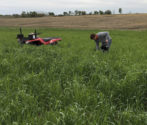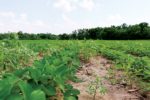Advertise Follow Us
Articles by Dan Crummett
Tracking & Tapping Into Natural Nitrogen Cycle Cuts Inputs
Iowa no-tiller Mitchell Hora uses weekly soil samples and the Haney test throughout the season to monitor naturally-available nutrients in corn and soybeans. The extra effort has cut his nitrogen rate in half.
Read More
Boosting Soil Biology by Farming Green on Green on Green
Young Illinois no-tiller overhauls conventional corn and soybean farm by planting and combining green while reducing nutrient applications and cutting pesticides for significant bottom-line payouts.
Read More
Managing Around Plant Disease Hotspots for 2020
Soilborne pathogens and fungal diseases are likely concerns for corn and soybean no-tillers this season, but pathologists say pay particular attention to soybean cyst nematodes, sudden death syndrome, tar spot and target spot.
Read More
Crop Protection Roundup 2020
New Crop Protection Tools For 2020 Growing Season
Unique chemistries to target resistant weeds and products to fight sucking insects and soil-born pests highlight new choices for no-till and conventional growers alike in new registrations for the coming year.
Read More
Waterhemp Continues Foiling Chemical Control
The discovery of waterhemp that is tolerant to a seventh class of herbicide action means growers have to double down on weed management by including cultural and mechanical controls to fight resistance.
Read More
Liquid Calcium Study Shows Little pH Effect
First-year results from a new Oklahoma study on the use of liquid calcium on bermudagrass pasture yielded no statistical differences in pH levels when compared with traditional liming agents.
Read More
Decoding C:N Ratios to Unlock Fertilizer Savings
The use of the right cover crops over an extended period can provide optimum soil C:N ratios for a thriving biological population and can significantly lower nutrient inputs over time.
Read More
Cotton, Sesame and Livestock Add Diversity to No-Till Operation
Southwestern Oklahoma farmers Matt and Bill Braun have watched their operation evolve from a conventional continuous wheat farm to an operation featuring cotton, sesame, livestock and cover crops.
Read More













